
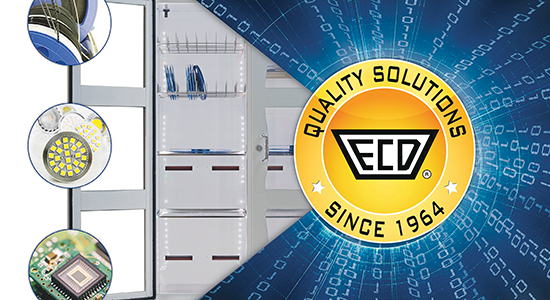
What is J-Standard compliance and why should you care? Is your operation in full compliance? Is your team adopting practices that may be sacrificing compliance? What’s your confidence level that moisture sensitive components have been stored correctly?
With the abundance of misleading information, outdated practices, and simple lack of understanding, you may be at risk of unintentionally producing suspect assemblies. This article covers the following key learning points:
1. Understand what J-STD compliance is and is not.
2. Tools and techniques used to get and maintain compliance, and the pros/cons of each.
3. Common misconceptions about MSLs (moisture sensitivity levels) that may impact product quality
Definitions and why J-STD matters
The misconception that placing components in dry storage will reset their floor life is worth mentioning, and is a good opportunity to distinguish between pausing versus resetting components' floor life. It is understood that baking a set of components at sufficient temperature for the appropriate length of time will reset their floor life clock. The schedule for performing a compliant bake is detailed in Table 4-1 of J-STD-033D and provides bake temperatures of 40°C, 90°C and 125°C.
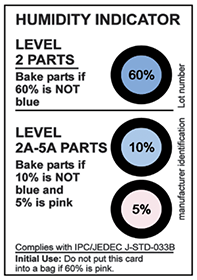
A dry cabinet, on the other hand (unless it has a baking feature), will simply pause the floor life clock for a given reel or tray of components. Once a component has exceeded its floor life exposure time, there is no schedule for how long it would take for it to be reset in a dry (less than 5% relative humidity, or RH) environment.
While it is true that the standard does have a provision for resetting components via a dry cabinet after short exposure times, it necessitates placing them in the dry environment for five or ten times the length of the short-term exposure (less than 12 hours for MSL levels 2, 2a, and 3; and less than 8&nobr;hours for MSL levels 4, 5, and 5a).
This means that simply storing the parts overnight in a dry cabinet after a day on the floor will not reset them for use the following day. For example, an MSL 2, 2a, or 3 component that spends 8 hours on the floor would require 40 hours in a dry cabinet to reset; and an MSL 4, 5, or 5a component with 8 hours exposure time would require 80 hours in a dry cabinet to reset.
This is the only way a dry cabinet can be used to 're-dry' parts, if the exposure times are short. This adds to the intricacy of dry storage logistics and often contributes to the impulse to bake everything.
Introduction to moisture sensitivity levels (MSL)
Moisture sensitivity level (MSL) describes how sensitive a given component is to absorbing ambient moisture at ambient humidity conditions (anything above 5% RH). This floor life clock is the amount of time a given component can be on the manufacturing floor before it absorbs a threshold of moisture that puts it at risk of defects such as popcorning or other moisture-related defects that can occur during manufacturing. Some of these defects are invisible to the naked eye and can pass initial quality inspection, but cause premature failure in the field.
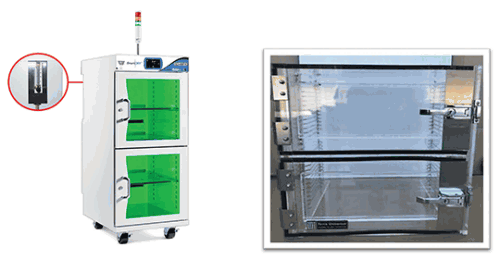
The floor life clock is determined by the MSL of the component and ranges from MSL 1, which allows for unlimited floor time, to MSL 6, which requires mandatory baking prior to use 100% of the time. For this reason, the discussion herein focuses on MSL 2-5, where some limited amount of floor time is allowed without having to bake the component.
In general, the higher the number, the more sensitive to moisture the component is. Some of these levels have subcategories, delineated as an 'a' suffix, which indicates a higher level of moisture sensitivity. For example, an MSL 2 component will allow for a floor time of 365 days, whereas an MSL 2a component will allow for just 28 days of floor time, and an MSL 3 component allows for 7 days.
Maintaining compliance
Maintaining compliance is a matter of ensuring MSD parts are not exposed to ambient humidity levels - or any humidity levels exceeding 5% RH - for longer than their specified floor life clock. If they do use up their floor life timer, maintaining compliance requires baking these components to reset their floor life timer before they are used in manufacturing.
So how do you ensure compliance with this standard in the normal storage of moisture sensitive devices (MSD)? It is important to set quality procedures and tracking around these J-STD MSL schedules, which can be achieved using various methods. Below are some storage methods for compliance, each with pros and cons.
Moisture barrier bags (MBBs)
Moisture barrier bags (MBBs) are sealable bags made of polyethylene and polyester or aluminium film, which protect against moisture penetrating the bag while it is sealed. MBBs are used in conjunction with humidity indicator cards (HICs - see Figure 1) to notify anyone handling the component if the seal has been compromised or if moisture has otherwise reached the component. MBBs must be packaged in a dry room, or more commonly with a desiccant packet, so the interior of the sealed bag is dry at the outset.

Benefits of MBBs used with HICs include convenience, ease of use, and low acquisition cost. The drawbacks of MBB use are increased man-hours for packaging and the residual cost of consuming the bags and cards over time. MBBs are also a one-time-use solution, since once the MBB is opened it must go through the sealing procedure again and requires a new desiccant packet.
Nitrogen (N2) cabinet
A nitrogen cabinet (Figure 2) is what often comes to mind when considering a desiccator cabinet. This is a clear, polyester or polycarbonate cabinet with connections for nitrogen drip or nitrogen purge functionality. These cabinets supply a continuous flow of nitrogen to maintain low humidity.
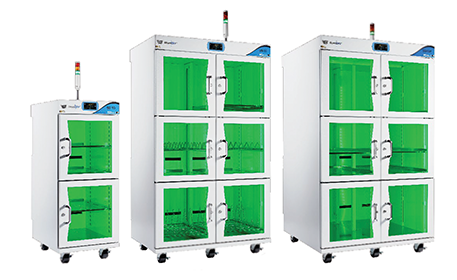
Pros of N2 cabinets include their ability to provide low humidity and inertness (prevention of oxidation). By filling the compartment with nitrogen, oxygen is forced out. This is very helpful in preventing oxidation of metal component leads that can lead to solderability issues. These are often utilised in cleanrooms, as they do not produce any particulates.
Some of the cons include the expense of nitrogen supply and the risk of nitrogen being out of compliance with the J-STD depending on the grade of nitrogen used, as the humidity of the nitrogen itself may exceed the 5% requirement. Nitrogen supplies can range from as low as 3% RH to as high as 8% RH.
Desiccant cabinets
A typical desiccant cabinet is made of metal construction with glass windows on the doors, and integrates dryer modules which are used to regenerate molecular-sieve desiccant beads such as zeolite (Figure 3). They allow air molecules to pass through, but trap the larger water molecules. Once the desiccant is saturated, the moisture is removed by heating the beads to evaporate the moisture. The minimum RH% attainable with molecular-sieve desiccant is 0,5% RH (not zero).
Benefits of a micro-sieve desiccant cabinet include the ability to maintain <5% RH for long-term storage of components. However, they are not as adept at inerting as N2 cabinets, and also produce particulates which are not suitable for cleanroom use. Cabinet accessibility (how often the door can be opened) can also be a hindrance, as some desiccant cabinets take 30-45 minutes to recover to <5% RH to be in compliance again with the J-STD. This means cabinet access more than once an hour would compromise compliance.
Next-generation desiccant cabinets
A modern desiccant cabinet (Figure 4) uses molecular-sieve (zeolite) as well, and has improved construction and performance with electronics manufacturing specifically in mind. This may include ESD protective surfaces, improved recovery time technology for greater accessibility, automatic data logging for audits and reports, or optional N2 plumbing for applications that need to be chemically inert.
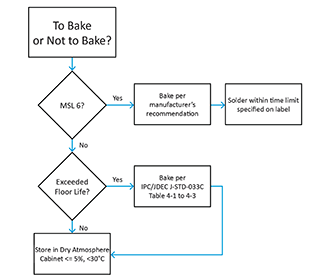
Benefits of modern desiccant cabinets include their ability to comply with J-STD, recovering to <5% RH in under 5 minutes in some cases. Many newer solutions also offer automatic data logging and visible status lighting which is helpful for compliance purposes. One drawback is that they are not as adept at inerting as N2 cabinets unless they have the option for nitrogen.
Common misconceptions
One of the more common misconceptions is that parts can simply be placed in dry storage for a given amount of time to reset their floor life clock. It's important to remember that placing components in dry storage will pause the floor life clock, but does not reset it. To reset the floor life clock, MSD components must be baked according to a J-STD-033 bake schedule, which will be discussed in the following section.
Another fallacy is that a custom bake schedule will be synonymous with an approved J-STD bake schedule. For example, assuming a bake can be performed at a hotter temperature like 140°C instead of the maximum approved temperature of 125°C to cut down the needed bake time is a common misconception. In short, unapproved bake schedules produce unapproved and unknown results.
Baking (schedules, resetting floor life clock)
Baking of components is required once the component's floor life clock has expired, as in the case of MSL 6 components. J-STD-033 lays out specific bake schedules, which vary in time for a given MSL part, and provides three different temperatures at which these parts can be baked: 40°C, 90°C, and 125°C.
In general, baking at higher temperatures will allow for a faster bake, which is convenient as some bake times can extend for days - or even weeks - depending on the thickness and MSL of the component. However, one must be conscious of the packaging, as temperatures of 125°C, or even 90°C, can damage component packaging, including tapes, trays and reels. If the packaging becomes warped or deformed, this can cause other problems in pick-and-place and assembly preparation.
In general, it is best to refer to Table 4-1 of your copy of J-STD-033 for 'Reference Conditions for Drying Mounted or Unmounted SMD Packages'. This provides the appropriate time and temperature of the bake for the MSL part (Figure 5), which can be referenced against the manufacturer specification for the maximum package temperature exposure prior to production.
Why is J-STD compliance important?
Risks of component failure or field failure due to invisible defects are significant problems. As mentioned previously, some manufacturing defects due to moisture exposure can be caused by micro-fractures inside a component package, not simply popcorning failures that are visible to the naked eye. This makes it difficult for automated optical inspection (AOI) systems and other quality management technologies to trigger a flag in production, and can result in entire lots of products reaching the field where failures may not be immediate.

For customers in high-reliability industries such as defence, aerospace, automotive, and medical, this simply isn't an option. The manufacture of missile guidance systems, anti-lock brake controllers, self-driving technology, or pacemakers requires fail-safe quality and control. There are countless examples of faulty airbags in cars, or anti-lock brake malfunction or airbag deployment mistakes that have resulted in injury, lost revenue and lawsuits far exceeding the cost of implementing a quality, standards-compliant manufacturing process. It is with these realities in mind that evaluation of quality processes, and a determination of the need for J-STD compliance, is highly encouraged.
| Tel: | +27 11 726 6758 |
| Email: | [email protected] |
| www: | www.eispty.co.za |
| Articles: | More information and articles about Electronic Industry Supplies |

© Technews Publishing (Pty) Ltd | All Rights Reserved